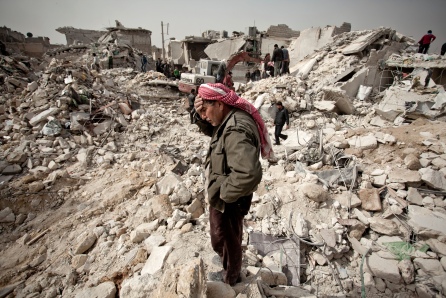The Islamic World and Sectarianism
- BY MIRZA MOHAMMED ALI KHAN
- IN ASIA · INTERNATIONAL · MID-EAST & AFRICA · PAKISTAN
- — 11 NOV, 2013
 Image courtesy of http://www.aimislam.com
Image courtesy of http://www.aimislam.com
With the Syrian stalemate finally looking like it is drawing to a close thanks to a possible solution on the table, one can only hope for a long overdue end to the bloody conflict. Exacerbated by its sectarian aspect, this conflict is the latest in a long history of sectarian conflicts that have been part of the Islamic world from the beginning.
Shias and Sunnis, the two major sects of Islam, are ideologically very different. While both sects share the belief in Allah being the only supreme power and Hazrat Mohammed being his prophet, appointing the prophet’s successor is where these two sects take different paths.
The Sunnis believe that the first of the ‘rightly guided’ caliphs was Abu Bakr, one of the prophet’s followers, while the Shias believe that the rightful successor to the Prophet was Hazrat Ali, the prophet’s cousin and son-in-law and the first of the 12 Shia Imams. Shia practices also differ from those of Sunnis. One major identity of Shia Muslims is their commemoration of Mohurram, the month when the third Shia Imam, Hazrat Husain, son of Hazrat Ali, was martyred in Karbala (present day Iraq).
Sunnis compose the majority of the global Muslim population, while Shias are a minority. Most Shias live in in Iran and Iraq, though a substantial number also inhabit Bahrain, Lebanon, Pakistan, Azerbaijan, India, and Syria. With this distribution in mind, we can now examine some contemporary sectarian conflicts.
SYRIA
War-torn Syria is a humanitarian disaster. Bashar al-Assad, an Alawite (considered an offshoot of Shia-ism) faced opposition from a predominantly Sunni rebel movement. Shia shrines, including that of Hazrat Sayyida Zainab, daughter of Hazrat Ali, were allegedly purposively targeted. Hezbollah, a radical Shia group based in Lebanon, have been drawn into the conflict as well, further complicating an already volatile situation and making this conflict more of a Shia-Sunni skirmish rather than the pro-democratic rebellion that it started off as.
It also complicates how the rest of the world responds. For example, the presence of the Jabhat al-Nusra, an Al-Qaeda linked jihadist group operating within the rebel groups fighting against Assad, makes arming or supporting the rebels a difficult pill to swallow.
BAHRAIN
The protests in Bahrain against the government started in early 2011. The monarchy which appoints the government is Sunni but the population is mostly Shia. There have been denials of this being a full-fledged sectarian conflict but this element cannot be ignored.
It is be possible that the Shias in Bahrain have been influenced by the Shia government established in Iran after the 1979 revolution by Ayatollah Khomeini. The government of Bahrain has accused Iran of fueling the fire and with a fresh wave of protests taking place as recently as August of this year, it certainly looks like this long standing issue will not be resolved any time soon.
PAKISTAN
Police Inspect the site of a roadside bomb in Quetta.
While it would not be completely right to cite Pakistan as an example of a sectarian ‘conflict’ in its conventional meaning, the brutality that this country witnesses in the form of sectarian violence is worth mentioning.
Shias form quite a large number in Pakistan, albeit a minority. It is interesting to note that the founder of Pakistan, Mohammed Ali Jinnah, was Shia. Most of the attacks on Shias are carried out during religious processions in the month of Mohurram in addition to Shia neighbourhoods being targeted like the bombing in Quetta in February of this year.
The major reasons for radical groups attacking Shia Muslims in Pakistan is the fact that these groups consider Shia practices to be heretical, and hence call for their elimination. Pakistan is now being viewed as increasingly unsafe for Shias.
PECULIARITIES
Within Shia-ism itself, different states have taken different approaches. While Iran after its revolution became a complete Shia-Islamic republic, Azerbaijan, with a population comprising 80-90% Shias, is a secular country and Iraq after the US-led intervention is a federal republic.
It comes as no surprise that Iran has supported Shia uprisings and leaders during conflicts, projecting itself as a rallying point for Shias all over the world. It has supported Assad in Syria,condemned Bahrain for cracking down on protests, and spoken against the violence against Shias in Pakistan. It has also been at loggerheads with Saudi Arabia and other Arab countries over the Syrian issue. It often looks like it is the Sunni Arab world against Shia Iran with sectarian politics at the core of it all.
Iran and Hezbollah have probably been among the most vocal in supporting the Palestinian cause although Palestinians are predominantly Sunni. Meanwhile, relations between Hezbollah, Iran and the Hamas (Sunni) are good despite them being strained over the Syrian issue.
While this may be no more than a case of uniting against their common enemy Israel, it goes to show that these two sects can come together for a common cause despite all their differences, thus raising hopes of reconciliation.
Going by the history of sectarian conflicts existing in Islam, it is impossible to say that these two sects can fully reconcile their differences. However, reconciling is possible and is absolutely necessary. The Middle East is at a crucial juncture, with its events affecting the rest of the world. The last thing we need is a full blown intra-religious conflict involving various countries to break out and wreck any semblance of a peace-building process.
Categories: Islam in the press

